Newark, Ohio
Newark (/ˈnɜːrk/ NURK) is a city in and the county seat of Licking County, Ohio, United States,[6] 33 miles (53 km) east of Columbus, at the junction of the forks of the Licking River. The population was 47,573 at the 2010 census, which makes it the 20th largest city in Ohio.
Newark | |
|---|---|
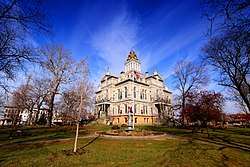 Licking County Courthouse | |
| Nickname(s): "Nerk” | |
| Motto(s): Land of Legend ⏤ Past and Future | |
 Location of Newark in Licking County and State of Ohio | |
 Newark Location of Newark in Licking County and State of Ohio  Newark Newark (the United States) | |
| Coordinates: 40°3′47″N 82°25′0″W | |
| Country | |
| State | |
| County | Licking |
| Government | |
| • Mayor | Jeff Hall |
| Area | |
| • Total | 21.37 sq mi (55.34 km2) |
| • Land | 20.88 sq mi (54.09 km2) |
| • Water | 0.48 sq mi (1.25 km2) |
| Elevation | 833 ft (254 m) |
| Population | |
| • Total | 47,573 |
| • Estimate (2019)[4] | 50,315 |
| • Density | 2,409.38/sq mi (930.26/km2) |
| Time zone | UTC−5 (Eastern (EST)) |
| • Summer (DST) | UTC−4 (EDT) |
| ZIP codes | 43055, 43056, 43058, 43093 |
| Area code(s) | 740, 220 |
| FIPS code | 39-54040[5] |
| GNIS feature ID | 1065144[2] |
| Website | http://www.newarkohio.net/ |
It is the site of much of the Newark Earthworks, a major ancient complex built by the Hopewell culture. The Great Circle portion and additional burial mounds are located in the neighboring city of Heath, Ohio. This complex has been designated as a National Historic Landmark and is operated as a state park by the Ohio History Connection.
History

Cultures of indigenous peoples lived along the river valleys for thousands of years before European contact. From more than two thousand years ago, 100 AD to 500 AD, people of the Hopewell culture transformed the area of Newark and Heath. They built many earthen mounds and enclosures, creating the single largest earthwork complex in the Ohio River Valley. The Newark Earthworks, designated a National Historic Landmark, have been preserved to document and interpret the area's significant ancient history. The earthworks cover several square miles and about 206 acres. This is operated as a state park by the Ohio History Connection.[7]
The Observatory Mound, Observatory Circle, and the interconnected Octagon earthworks span nearly 3,000 feet (910 m) in length. The Octagon alone is large enough to contain four Roman Coliseums. The Great Pyramid of Giza in Egypt would fit precisely within Observatory Circle. The even larger 1,180-foot (360 m)-diameter Newark Great Circle, located in Heath, is the largest circular earthwork in the Americas. The 8 feet (2.4 m)-high walls surround a 5 feet (1.5 m)-deep moat. At the entrance, the walls and moat are of greater and more impressive dimensions.
Contemporary archaeogeodesy and archaeoastronomy researchers have demonstrated that the Hopewell and other prehistoric cultures had advanced scientific understandings which they used to create their earthworks for astronomical observations, markings and celebrations. Researchers analyzed the placements, alignments, dimensions, and site-to-site interrelationships of the Hopewell earthworks to understand what had been done. Today, the Ohio Historical Society preserves the Great Circle Earthworks in a public park near downtown Newark, called Mound Builders Park (or the Newark Earthworks) located at 99 Cooper Ave, Newark, Ohio. The area of the Octagon Earthworks had been leased to a country club, but new arrangements in 1997 provide for more public access to it. Later American Indian tribes inhabiting the area at the time of European contact were distant descendants of the Hopewell peoples.
European-American settlement
After exploration by traders and trappers in earlier centuries, the first European-American settlers arrived in 1802, led by Gen. William C. Schenck. He named the new village after his New Jersey hometown.
Nineteenth-century investment in infrastructure resulted in growth in the town after it was linked to major transportation and trade networks. On July 4, 1825, Governors Clinton of New York and Morrow of Ohio dug the first shovelfuls of dirt for the Ohio and Erie Canal project, at the Licking Summit near Newark, Ohio. On April 11, 1855, Newark became a stop along the Pittsburgh, Cincinnati, Chicago and St. Louis Railroad that was built to connect Pittsburgh to Chicago and St. Louis. On April 16, 1857, the Central Ohio Railroad connected Newark west to Columbus, and later Newark maintained a station on the Baltimore and Ohio Railroad.
The Heisey Glass Company started in Newark in 1895. The factory operated there for 62 years, until the company's demise in 1957 due to changing tastes. The National Heisey Glass Museum, operated by the Heisey Collectors of America, Inc., is located on Sixth Street in Newark.
In 1909, The Arcade was opened. Modeled after innovative European retail buildings, it became one of Newark's first successful retail emporiums. Later versions of buildings that contained a variety of shops indoors became known as shopping malls. At 60,000 square feet (5,600 m2), the Arcade is one-third the size of an average modern Wal-Mart.
Geography
According to the United States Census Bureau, the city has a total area of 21.37 square miles (55.35 km2), of which 20.88 square miles (54.08 km2) is land and 0.49 square miles (1.27 km2) is water.[8] Newark is located at 40°3′47″N 82°25′0″W (40.063014, −82.416779).[9]
Demographics
| Historical population | |||
|---|---|---|---|
| Census | Pop. | %± | |
| 1810 | 232 | — | |
| 1820 | 410 | 76.7% | |
| 1830 | 999 | 143.7% | |
| 1840 | 2,705 | 170.8% | |
| 1850 | 3,654 | 35.1% | |
| 1860 | 4,675 | 27.9% | |
| 1870 | 6,698 | 43.3% | |
| 1880 | 9,600 | 43.3% | |
| 1890 | 14,270 | 48.6% | |
| 1900 | 18,157 | 27.2% | |
| 1910 | 25,404 | 39.9% | |
| 1920 | 26,718 | 5.2% | |
| 1930 | 30,596 | 14.5% | |
| 1940 | 31,487 | 2.9% | |
| 1950 | 34,275 | 8.9% | |
| 1960 | 41,790 | 21.9% | |
| 1970 | 41,836 | 0.1% | |
| 1980 | 41,162 | −1.6% | |
| 1990 | 44,389 | 7.8% | |
| 2000 | 46,279 | 4.3% | |
| 2010 | 47,573 | 2.8% | |
| Est. 2019 | 50,315 | [4] | 5.8% |
| Sources:[10][11][5] | |||
In terms of population, Newark, Ohio is the second-largest Newark in the United States, after Newark, New Jersey. Newark, Ohio is part of the Columbus, Ohio metropolitan area. The median income for a household in the city was $19,791, and the median income for a family was $42,138. Males had a median income of $18,542 versus $12,868 for females. The per capita income for the city was $17,819. About 10.1% of families and 13.0% of the population were below the poverty line, including 17.9% of those under age 18 and 9.0% of those age 65 or over.
2010 census
As of the census[3] of 2010, there were 47,573 people, 19,840 households, and 12,057 families residing in the city. The population density was 2,278.4 inhabitants per square mile (879.7/km2). There were 21,976 housing units at an average density of 1,052.5 per square mile (406.4/km2). The racial makeup of the city was 92.8% White, 3.3% African American, 0.3% Native American, 0.6% Asian, 0.3% from other races, and 2.6% from two or more races. Hispanic or Latino of any race were 1.2% of the population.
There were 19,840 households of which 30.8% had children under the age of 18 living with them, 40.7% were married couples living together, 14.8% had a female householder with no husband present, 5.3% had a male householder with no wife present, and 39.2% were non-families. 31.9% of all households were made up of individuals and 12.3% had someone living alone who was 65 years of age or older. The average household size was 2.35 and the average family size was 2.94.
The median age in the city was 37.3 years. 24% of residents were under the age of 18; 9.9% were between the ages of 18 and 24; 25.6% were from 25 to 44; 26% were from 45 to 64; and 14.5% were 65 years of age or older. The gender makeup of the city was 47.8% male and 52.2% female.
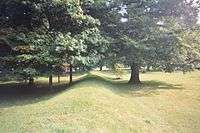 Great Circle at Newark Earthworks
Great Circle at Newark Earthworks McGuffey Elementary School, used also as West Main Intermediate
McGuffey Elementary School, used also as West Main Intermediate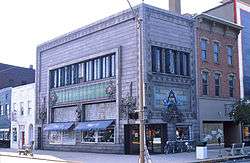 Home Savings Association Bank, Louis Sullivan, architect
Home Savings Association Bank, Louis Sullivan, architect The Midland Theatre on Courthouse Square
The Midland Theatre on Courthouse Square- Shields Block
 Family Outing, sculpture by Gary Lee Price, Thomas Evans Bike Trail, west of downtown
Family Outing, sculpture by Gary Lee Price, Thomas Evans Bike Trail, west of downtown- Upham-Wright House
 Home in the Hudson Avenue Historic District
Home in the Hudson Avenue Historic District- Cedar Hill Cemetery
- Nearby Dawes Arboretum south of Newark
Business
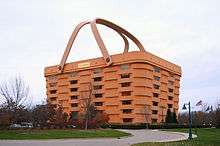
Newark is the site of several major manufacturers. Holophane, founded in 1898, is one of the world's oldest manufacturers of lighting-related products. The main factory of Owens Corning Fiberglass is also located in Newark. State Farm Insurance has Regional Headquarters here. The Park National Bank Corporation is headquartered in downtown Newark.
Several industrial parks have been developed and house such major companies as Kaiser Aluminum, Dow Chemical Company, General Electric, Covestro, Boeing, THK, Harry & David, Communicolor, Diebold, Anomatic, International Paper, and Tamarack Farms Dairy. Longaberger, a major basket-maker, had their new corporate headquarters in Newark designed as a gigantic "medium market basket," their most popular model.
The main shopping center in the area is the Indian Mound Mall, located in nearby Heath. The mall is named for the internationally known, ancient complex called the Newark Earthworks, built 2,000 years ago by the Hopewell culture of central Ohio.[12] It is a National Historic Landmark and major elements of the earthworks are located less than a mile away from the shopping mall named for them.
Education
Newark City School District serves the city of Newark. Newark High School consists of nearly 2,000 students and competes at the OHSAA D1 level. Newark High School has a storied tradition in Academics and Sports, as well as Performing Arts. Newark High School has won 4 OHSAA Basketball titles (36', 38', 43', 08') and 3 AP Football titles. The Pride of Newark Marching Band has made an unprecedented 39 consecutive years to the OMEA state finals. The Pride has earned a superior rating at State Marching Band finals 31 years, including 4 straight seasons (2015, ‘16, ‘17, ‘18). The Newark High School Sinfonia, under the direction of Susan Larson, tied for first runner-up at the National Orchestra Cup in New York City on April 5, 2009. The Sinfonia was featured in a front-page article of the April 14, 2009, edition of The New York Times, and received an invitation to the White House in the fall of 2009. Their Concert Choir recently sang in Italy and was sponsored by Disney. Under the direction of Kimberly & Michael Wigglesworth, the choir has qualified for OMEA Choir state Finals for the past 15 years.
A regional campus of Ohio State University is also located in the city. The Ohio State University at Newark, founded in 1957, schools over 2,800 students and is the most diverse campus in the Ohio State system. Today, under the leadership of Dean and Director William MacDonald, the campus features eleven buildings, including a recreation center and two residence halls. It offers Associate of Arts degrees, as well as Bachelor of Arts degrees in seven majors and master's degrees in education and social work. It also serves as a doorway to over 200 majors on the Ohio State University campus in Columbus. The Newark Campus shares its facilities with a two-year technical college, COTC (Central Ohio Technical College). Under the leadership of President Bonnie Coe, it serves some 3,000 other students in 45 certificate and associate degree programs.
Newark is also home to a number of private religious schools, including Blessed Sacrament School and Newark Catholic High School. C-TEC (Career and Technology Education Centers of Licking County) offers high school and adult programs.
Newark has a public library, a branch of the Licking County Library System.[13]
Transportation
Licking County provided demand-response public transportation under the name Licking County Transit.[14] GoBus' Columbus-Wooster route provides service to Newark.
Climate
| Climate data for Newark, Ohio | |||||||||||||
|---|---|---|---|---|---|---|---|---|---|---|---|---|---|
| Month | Jan | Feb | Mar | Apr | May | Jun | Jul | Aug | Sep | Oct | Nov | Dec | Year |
| Record high °F (°C) | 76 (24) |
75 (24) |
85 (29) |
90 (32) |
95 (35) |
101 (38) |
106 (41) |
101 (38) |
103 (39) |
90 (32) |
81 (27) |
76 (24) |
106 (41) |
| Average high °F (°C) | 36 (2) |
40 (4) |
51 (11) |
63 (17) |
73 (23) |
82 (28) |
85 (29) |
84 (29) |
77 (25) |
66 (19) |
52 (11) |
40 (4) |
62 (17) |
| Average low °F (°C) | 20 (−7) |
21 (−6) |
29 (−2) |
39 (4) |
48 (9) |
57 (14) |
61 (16) |
60 (16) |
52 (11) |
41 (5) |
32 (0) |
23 (−5) |
40 (5) |
| Record low °F (°C) | −24 (−31) |
−26 (−32) |
−7 (−22) |
12 (−11) |
23 (−5) |
32 (0) |
41 (5) |
38 (3) |
25 (−4) |
14 (−10) |
−4 (−20) |
−21 (−29) |
−26 (−32) |
| Average precipitation inches (mm) | 3.1 (79) |
2.5 (64) |
3.5 (89) |
3.8 (97) |
4.2 (110) |
4.5 (110) |
4.3 (110) |
3.6 (91) |
2.9 (74) |
2.6 (66) |
3.0 (76) |
2.9 (74) |
40.9 (1,040) |
| Source: Weatherbase[15] | |||||||||||||
Notable people
- Gary A. Braunbeck, award-winning horror author
- John Clem (AKA "Johnny Shiloh"), one of the youngest-known soldier in U.S. Army
- Mike Collins, football player for NFL's Detroit Lions and St. Louis Rams
- Katharine Coman, economic historian, professor at Wellesley College; credited with developing the field of industrial history; was the first female professor to teach statistics in the US
- Woody English, MLB player for Chicago Cubs
- Jon Hendricks, jazz singer
- Derek Holland, MLB starting pitcher for San Francisco Giants, Chicago White Sox, Texas Rangers
- Che Jones, college basketball player; jersey number retired by Ohio State-Newark in 2001
- Rob Kelly, five-year NFL pro with the New Orleans Saints and New England Patriots
- Roman Mars, host and producer of 99% Invisible
- Andy Merrill, the voice of Brak (the main character in The Brak Show and Cartoon Planet on Cartoon Network).
- Jerrie Mock, first woman to fly solo around the world
- Bruce Mozert, photographer
- Wayne Newton, singer, actor, Las Vegas Strip entertainer; raised in Newark
- Kathi Norris, writer and television presenter
- Henry Putnam, Wisconsin State Senator
- Edward James Roye, President of Liberia from 1870–1871
- Fred Schaus, Hall of Fame head coach of NBA's Los Angeles Lakers, Purdue and West Virginia
- William Stanbery, U.S. Congressman
- G. David Thompson (1899-1965), investment banker, industrialist, and modern art collector[16]
- Jim Tyrer, professional football player for Kansas City Chiefs and Washington Redskins
- Jeff Uhlenhake, 12-year NFL pro with Miami Dolphins, Washington Redskins and New Orleans Saints
- Geoffrey C. Ward, historian and writer
- Clarence Hudson White, early photographer, member of modernist "Photo Secessionist" group
- Michael Z. Williamson, science fiction author
- Charles R. Woods, Civil War general
- William Burnham Woods, U.S. Supreme Court Associate Justice
References in culture
- Isaac Asimov refers to the Newark Earthworks in a short story.
- Robert Silverberg's novella Born With The Dead is set partly in Newark, and refers to the Great Circle and Octagon Mounds
- Parts of The Tales of Alvin Maker series of novels by Orson Scott Card refer to the earthworks.

- Gary A. Braunbeck sets much of his fiction in Cedar Hill, a city based on Newark.
- Parts of James Frey's highly successful book, A Million Little Pieces, are based in and around Newark.
See also
References
- "2019 U.S. Gazetteer Files". United States Census Bureau. Retrieved July 28, 2020.
- "US Board on Geographic Names". United States Geological Survey. 2007-10-25. Retrieved 2008-01-31.
- "U.S. Census website". United States Census Bureau. Retrieved 2013-01-06.
- "Population and Housing Unit Estimates". Retrieved May 21, 2020.
- "U.S. Census website". United States Census Bureau. Retrieved 2008-01-31.
- "Find a County". National Association of Counties. Retrieved 2011-06-07.
- "History". Ohio History Connection. 2016. Retrieved 9 September 2016.
- "US Gazetteer files 2010". United States Census Bureau. Archived from the original on 2012-01-25. Retrieved 2013-01-06.
- "US Gazetteer files: 2010, 2000, and 1990". United States Census Bureau. 2011-02-12. Retrieved 2011-04-23.
- "Number of Inhabitants: Ohio" (PDF). 18th Census of the United States. U.S. Census Bureau. 1960. Retrieved 17 May 2020.
- "Ohio: Population and Housing Unit Counts" (PDF). U.S. Census Bureau. Retrieved 17 May 2020.
- Ohio State Parks: Great Circle Earthworks
- "Hours & Locations". Licking County Library System. Retrieved 26 February 2018.
- "Licking County - Public Transportation". Retrieved 2018-10-22.
- "Weatherbase: Historical Weather for Newark, Ohio, United States of America". July 2011.
- "Thompson, G. David". MetMuseum. Retrieved 25 September 2015.
Bibliography
- Smucker, Isaac (1807-1894): Recollections of Newark, Ohio Archæological and Historical Society Publications: Volume 20 [1911], pp. 240–247.
External links
| Wikisource has the text of a 1911 Encyclopædia Britannica article about Newark, Ohio. |
- City of Newark, Ohio
- Community resource website for Newark, Ohio
- OSU-Newark and COTC

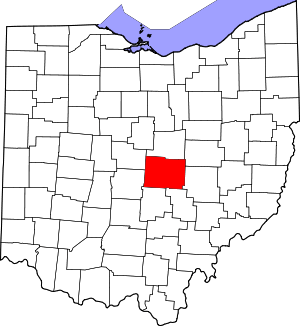
.svg.png)
